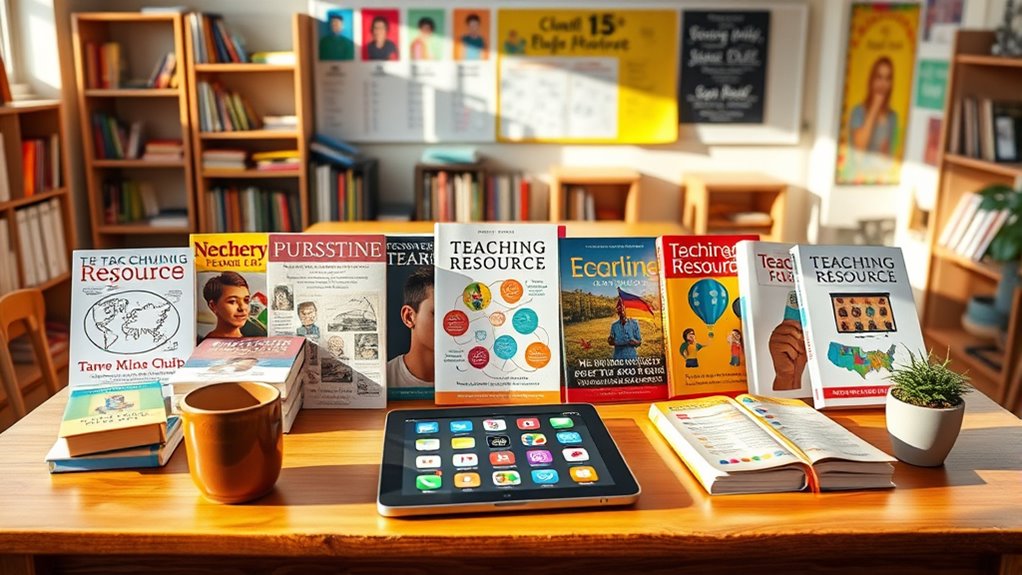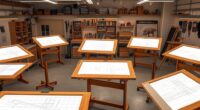If you’re looking for the 15 best teaching resource books for 2025, I recommend key titles across literacy, ESL, classroom planning, early childhood, and higher education. These include practical guides like the Teaching Reading Sourcebook, ESL resources such as Reading, Writing, and Learning in ESL, and organizational tools like the Teacher Record Book. Each offers evidence-based strategies and user-friendly formats to support your teaching journey. Keep exploring, and you’ll uncover the essential tools to elevate your classroom expertise.
Key Takeaways
- The list includes diverse resources covering literacy, ESL, early childhood, classroom management, and higher education strategies for comprehensive teaching support.
- Essential books feature research-based methods, practical activities, and tools to enhance student engagement and learning outcomes across all grade levels.
- Modern resources incorporate technology integration, evidence-based practices, and strategies tailored for multilingual learners and special education needs.
- The collection emphasizes organization, planning, and record-keeping tools to streamline educators’ workflow and improve classroom management.
- Updated for 2025, these books reflect the latest educational research, innovative teaching techniques, and inclusive practices for diverse learners.
Teaching Reading Sourcebook (Core Literacy Library)
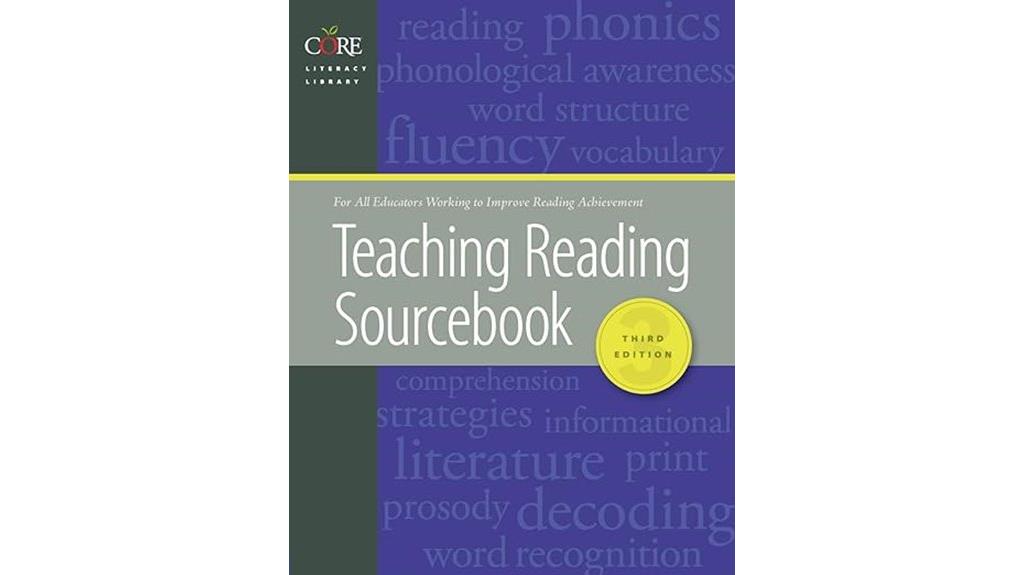
Are you a K-2 or early elementary teacher looking for an all-inclusive guide to teaching reading? The Teaching Reading Sourcebook from the Core Literacy Library is exactly what you need. It’s designed for teachers, EL, and SPED educators, offering a research-based, practical approach to literacy instruction. The book covers essential components like phonemic awareness, phonics, fluency, vocabulary, and comprehension. Organized around guiding questions—what, why, when, how—it combines theory with step-by-step lesson models, assessments, and interventions. Plus, its user-friendly layout makes it easy to implement in any classroom. It’s a trusted resource for professional growth and effective reading instruction.
Best For: K-2 and early elementary teachers, EL, and SPED educators seeking a comprehensive, research-based guide to literacy instruction.
Pros:
- Combines academic research with practical lesson models for ease of implementation.
- Organized around guiding questions to support effective, explicit instruction.
- Includes assessments, interventions, and a new section on MTSS for comprehensive support.
Cons:
- May be dense for educators preferring quick reference guides; requires time to fully utilize.
- Slight printing issues reported, although overall quality remains high.
- Designed primarily for early elementary, less suited for upper-grade or specialized reading needs.
Reading, Writing, and Learning in ESL: Resource Book for K-12 English Learners
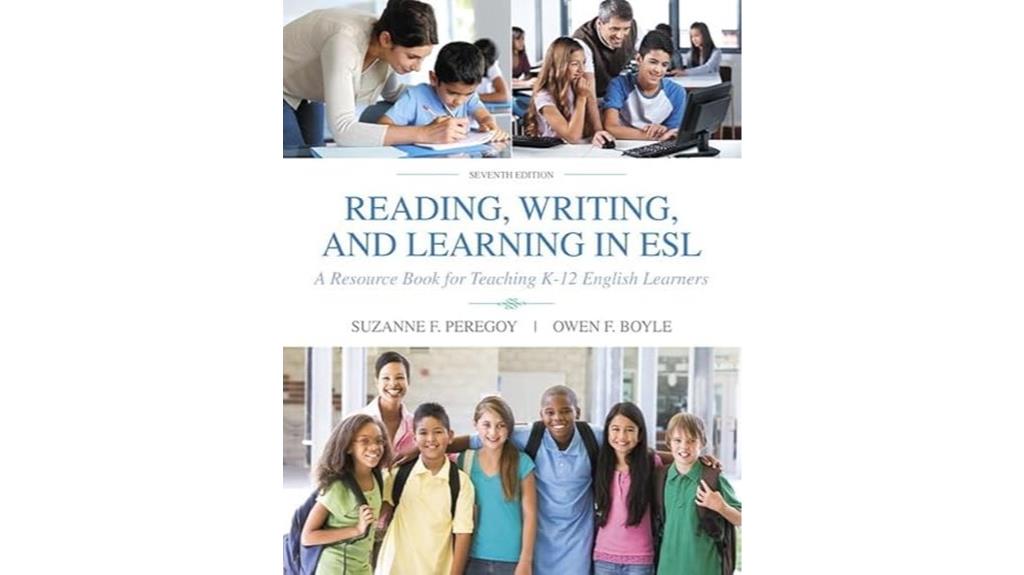
If you’re an educator working with K-12 English learners, “Reading, Writing, and Learning in ESL” stands out as an essential resource. It offers evidence-based strategies to motivate and involve students across oral language, reading, writing, and academic content areas. The book includes practical activities, digital technology integration, and new teaching approaches. Its formats—print and Enhanced Pearson eText—provide multimedia tools, assessments, and offline access. While the content is thorough and research-backed, some find the writing style a bit dry. Still, it’s a valuable tool for deepening your understanding of ESL instruction and engaging learners effectively.
Best For: educators and ESL specialists seeking a research-based, comprehensive resource to enhance instruction for K-12 English learners through practical strategies, digital tools, and content integration.
Pros:
- Evidence-based strategies for motivating and involving students across language and academic areas
- Includes practical activities, digital technology integration, and current teaching approaches
- Available in multimedia-enhanced formats with assessments and offline access
Cons:
- Some users find the writing style dry and academically dense, which may affect engagement
- Technical issues reported, such as difficulties with eBook access, videos not functioning, and device compatibility problems
- The physical book does not include access to the Enhanced Pearson eText, potentially requiring additional purchases
Teacher Record Book
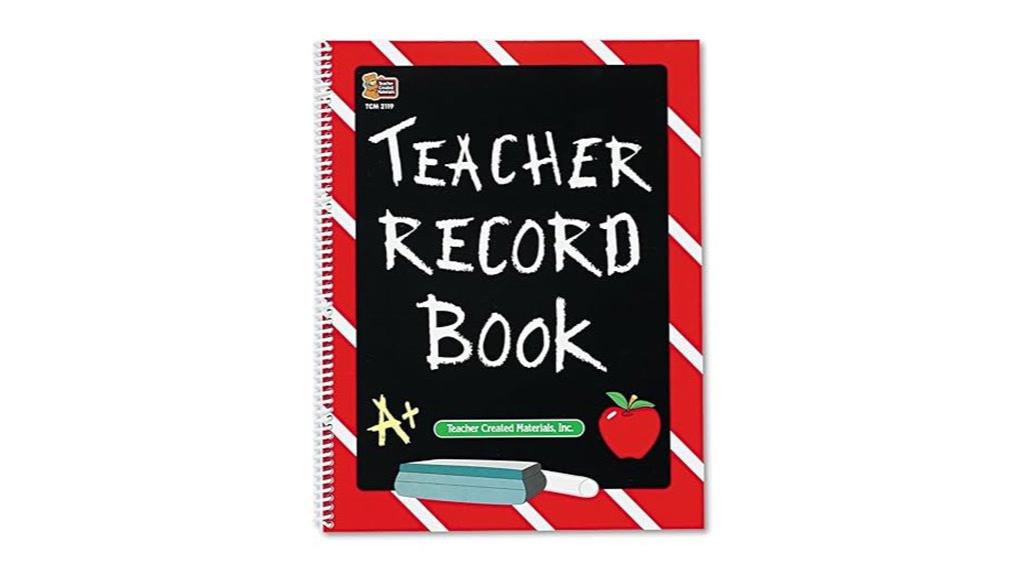
A Teacher Record Book is an essential tool for educators who want to keep their student information organized and easily accessible. It helps me track attendance, test scores, and other crucial details efficiently. With ample writing space and perforated pages, I can quickly organize and remove records when needed. Its layout supports consistent documentation across multiple pages, ensuring I stay on top of student progress from kindergarten through 12th grade. This versatile resource is suitable for any grade level, making record-keeping seamless across different teaching environments. Ultimately, it promotes better organization, saving time and reducing stress during busy school days.
Best For: educators at all grade levels seeking an organized, efficient way to track student attendance, test scores, and progress from kindergarten through 12th grade.
Pros:
- Provides ample writing space for detailed record-keeping
- Perforated pages allow for easy removal and organization
- Supports consistent documentation across multiple pages and grade levels
Cons:
- May be too large for teachers with limited storage space
- Not customizable for specific record-keeping needs
- Can become bulky if filled with numerous student records
7 Mighty Moves Reading Resources
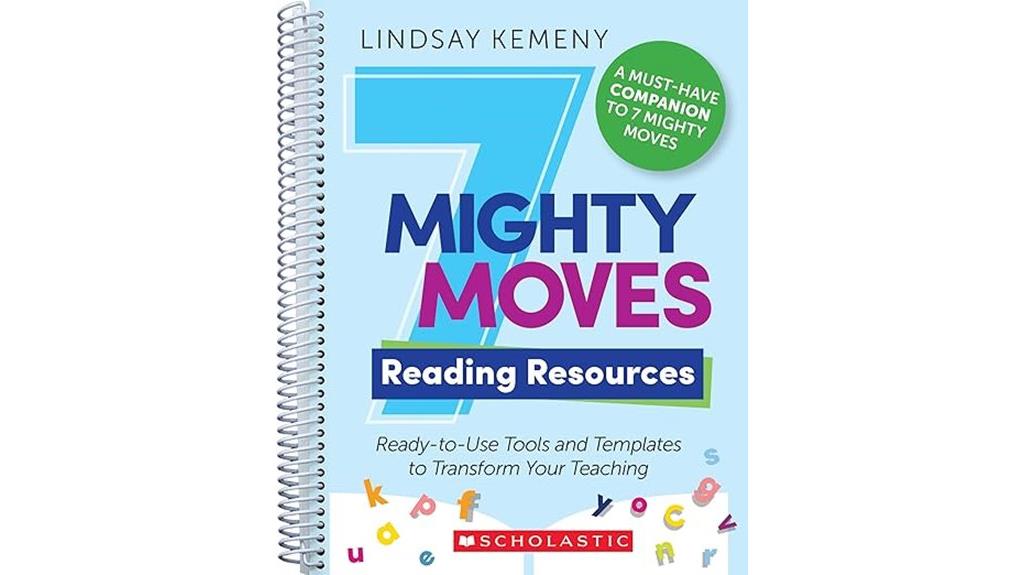
Educators looking for practical, research-based tools to strengthen their foundational reading instruction will find the “7 Mighty Moves Reading Resources” an invaluable asset. This all-encompassing companion offers 320 pages of ready-to-use materials, including lesson plan templates, word lists, student worksheets, picture cards, and assessment tools. Designed to support a shift from balanced literacy to evidence-based practices, it’s perfect for whole group, small group, or one-on-one instruction. The resources are classroom-tested, easy to implement, and emphasize differentiation and immediate usability. Despite minor print quality issues, it’s widely praised for its clear guidance and practical activities, making it a must-have for effective literacy teaching.
Best For: elementary educators, literacy specialists, and graduate students seeking ready-to-use, research-based tools to enhance foundational reading instruction across various classroom settings.
Pros:
- Classroom-tested resources including lesson plans, word lists, and activities for immediate use
- Supports a transition from balanced literacy to evidence-based, structured literacy practices
- Easy-to-implement, differentiation-focused materials suitable for whole group, small group, or individual instruction
Cons:
- Some users report print quality issues such as blurred or torn pages
- The extensive contents may require careful navigation to locate specific resources quickly
- As a companion to “7 Mighty Moves,” it may be less effective without access to the main guide
Reading, Writing, and Learning in ESL: Resource Book for Teaching K-12 Multilingual Learners
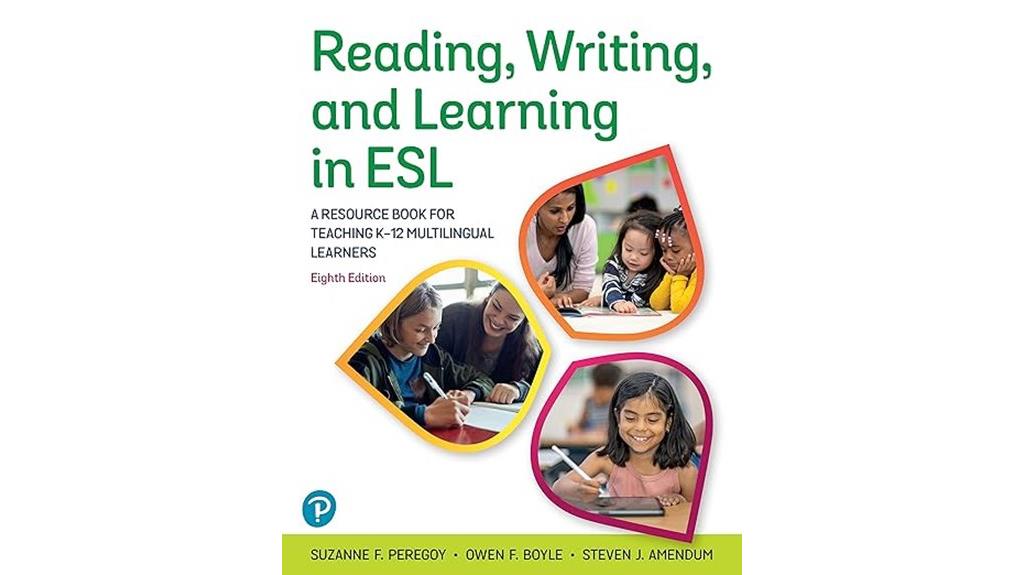
Are you seeking a practical, research-based guide tailored specifically for teaching K-12 multilingual learners? “Reading, Writing, and Learning in ESL” stands out as an essential resource for educators who want to actively engage their students in meaningful language development and academic growth. This extensive book offers evidence-based strategies grounded in current theories of language acquisition, providing practical classroom applications. It includes updated case studies, real-life scenarios, and research findings that help teachers support diverse multilingual classrooms effectively. If you’re dedicated to enhancing your instruction and fostering student success, this resource is a must-have in your teaching toolkit for 2025.
Best For: educators seeking a comprehensive, research-based resource to effectively teach and support multilingual K-12 learners in language development and academic growth.
Pros:
- Offers evidence-based strategies grounded in current language acquisition theories.
- Includes updated case studies, real-life scenarios, and research findings for practical application.
- Focuses on engaging students actively in meaningful language learning experiences.
Cons:
- May require familiarity with current educational terminology and research to fully utilize content.
- The extensive scope could be overwhelming for new educators or those seeking quick reference guides.
- Some strategies may need adaptation to fit specific classroom contexts or student needs.
Reading, Writing, and Learning in ESL: Resource Book for K-12 English Learners (6th Edition)
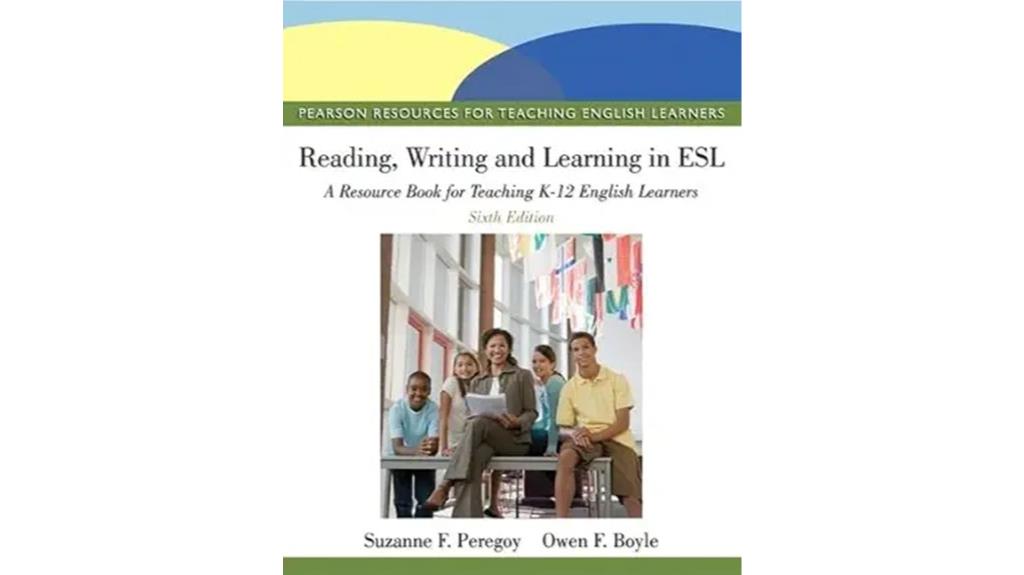
If you’re looking for a practical, research-based guide to support K-12 teachers working with English Learners, “Reading, Writing, and Learning in ESL: Resource Book for K-12 English Learners (6th Edition)” is an excellent choice. This extensive resource offers clear strategies grounded in current research for teaching and evaluating oral language, vocabulary, reading, and writing. It emphasizes integrating literacy across subjects and adapting lessons to meet diverse student needs. The latest edition introduces new content on academic language, internet reading demands, and Response to Intervention (RTI). It’s an invaluable tool for motivating ELs and enhancing their language and literacy development in inclusive classrooms.
Best For: K-12 teachers seeking a research-based, practical resource to enhance instruction and assessment for English Learners in diverse classroom settings.
Pros:
- Provides comprehensive, evidence-based strategies for teaching oral language, vocabulary, reading, and writing.
- Incorporates current research and new material on academic language, internet reading, and RTI to stay relevant to modern educational needs.
- Includes numerous Internet resources to support innovative teaching practices and student engagement.
Cons:
- May be overwhelming for new teachers due to its extensive content and detailed strategies.
- Some teachers might find the focus on diverse classroom adaptations requires additional training or resources.
- The digital and internet-based resources may require reliable internet access and technological familiarity.
100 Words Kids Need to Read by 1st Grade: Sight Word Practice
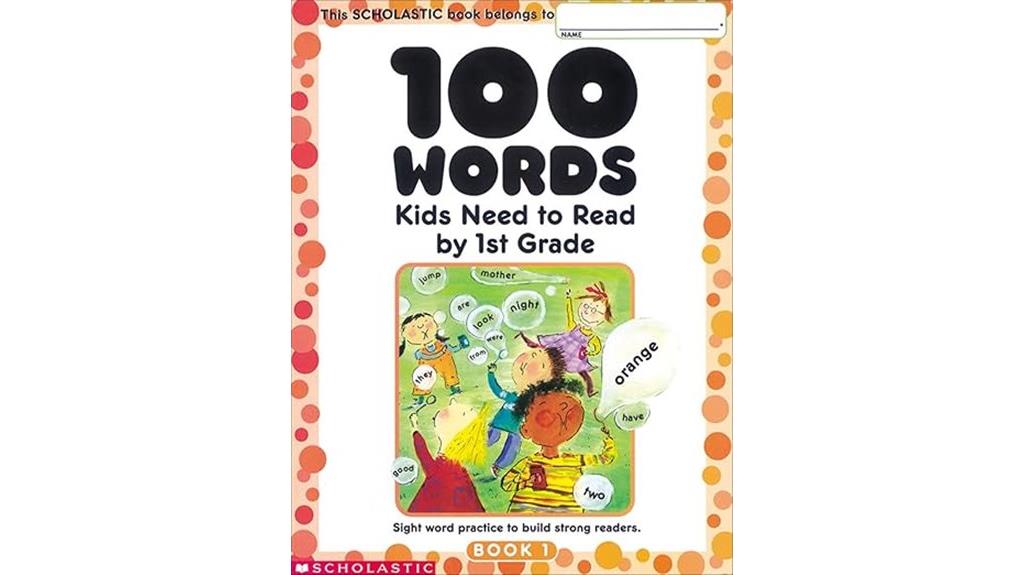
Looking for a practical tool to help first graders master essential sight words? This workbook focuses on 100 key words crucial for early reading success. It boosts comprehension, spelling, and writing skills through fun activities like fill-in-the-blank stories, riddles, and puzzles. Kids practice using words in context, improving their grasp and confidence. Additional exercises, such as Guess the Word, sorting, and irregular verb practice, deepen vocabulary and grammar understanding. The inclusion of proofreading tasks sharpens reading accuracy and attention to detail. This resource makes sight word mastery engaging and effective, setting a strong foundation for young readers.
Best For: parents and teachers seeking an engaging, effective way to help first graders master essential sight words and build foundational reading skills.
Pros:
- Promotes comprehensive literacy skills including comprehension, spelling, and writing
- Uses diverse, fun activities like riddles, puzzles, and context-based stories to boost engagement
- Enhances vocabulary and grammar understanding through targeted exercises like sorting and irregular verb practice
Cons:
- May require supervision to ensure children complete activities correctly
- Some students might find repetitive exercises less stimulating over time
- Limited focus on advanced reading skills beyond initial sight word mastery
The Complete Resource Book for Preschoolers
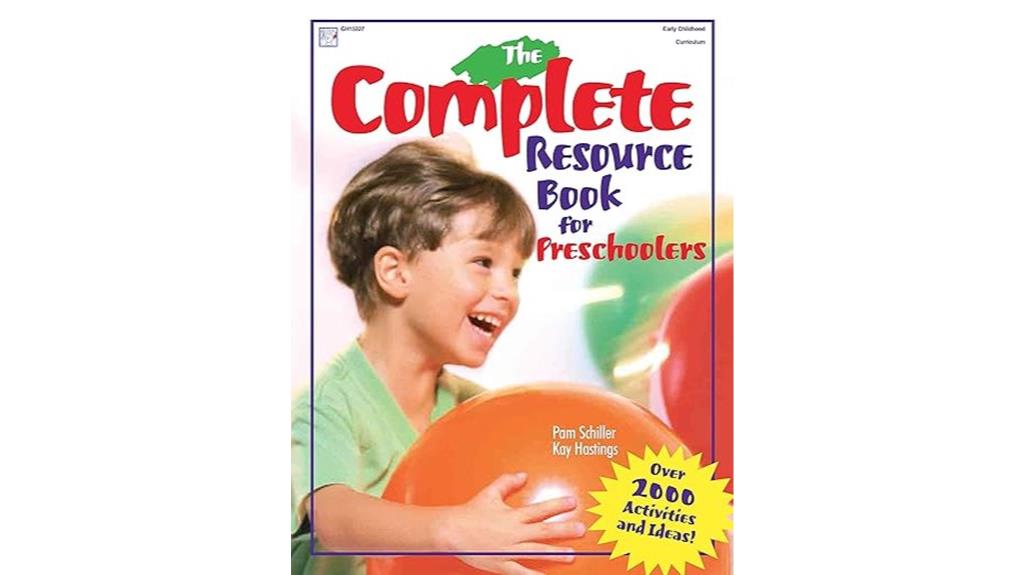
The Complete Resource Book for Preschoolers stands out as an essential tool for early childhood educators seeking an all-inclusive planning guide. With over 2000 activities and ideas, it covers every aspect of preschool teaching, from daily routines to engaging learning centers. I rely on it to respond to children’s interests, ensuring my lessons are relevant and fun. The book’s daily plans, songs, recipes, and games make planning straightforward and dynamic. It’s like having a master teacher by my side, inspiring creativity and consistency throughout the year. This resource truly streamlines classroom management while enriching the preschool experience for every child.
Best For: early childhood educators and preschool teachers seeking a comprehensive, easy-to-use planning resource to enhance classroom activities and manage daily routines effectively.
Pros:
- Offers over 2000 activities and ideas, ensuring a wide variety of engaging options.
- Provides detailed daily plans, songs, recipes, and games to streamline lesson planning.
- Serves as a versatile resource that supports curriculum development, classroom management, and responding to children’s interests.
Cons:
- May be overwhelming for new teachers due to the extensive number of activities and ideas.
- The book’s breadth could require time to fully explore and utilize all sections.
- Some activities may need adaptation to fit specific classroom settings or age groups.
First Little Readers Parent Pack
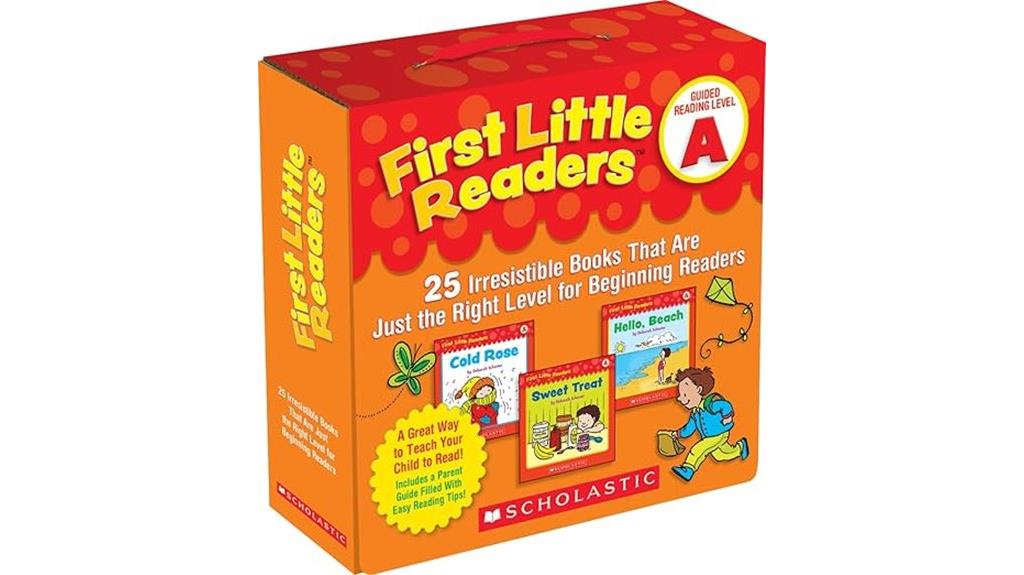
The First Little Readers Parent Pack is ideal for children who have already grasped basic sight words and phonics skills, making it perfect for preschool and kindergarten students progressing beyond absolute beginner status. These 25 colorful, engaging books are designed to build confidence with simple, repetitive sentences and realistic illustrations. Suitable for children who’ve had success with beginner series like Bob Books, the pack introduces longer sentences and multisyllabic words gradually. Accompanied by parent guides, these books support early reading development at home or in the classroom, making learning fun and manageable as children develop foundational decoding and recognition skills.
Best For: children who have already mastered basic sight words and phonics, and are ready to progress to more complex sentences and vocabulary in early reading.
Pros:
- Builds confidence with repetitive, simple sentence structures and engaging illustrations
- Covers a variety of topics that appeal to young children, such as seasons, animals, and daily activities
- Comes with helpful parent guides to support effective reading practice at home or in the classroom
Cons:
- Not suitable for absolute beginners who have not yet learned basic sight words or phonics
- Some books may contain slightly more complex vocabulary, requiring additional support
- A few reviewers note that the series may include minor duplicates or difficulty differentiating between sets
Teaching at Its Best: A Research-Based Resource for College Instructors
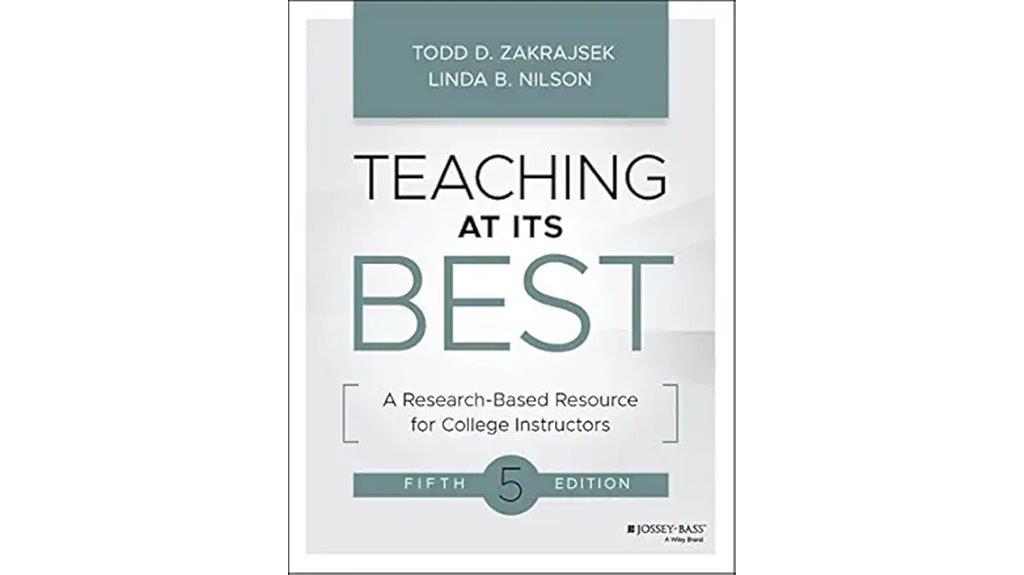
Are you seeking a practical, research-based guide to elevate your teaching skills in higher education? “Teaching at Its Best” is an ideal resource for both new and experienced college instructors who want evidence-backed strategies to improve student engagement and learning. This all-encompassing, accessible book covers essential topics like active learning, effective feedback, and course design, integrating recent research and diverse perspectives. Updated through collaboration between Todd Zakrajsek and Linda Nilson, it offers practical guidance for face-to-face and online teaching. With reflection questions and real-world applications, it’s a valuable tool to foster dynamic, motivating classroom environments.
Best For: college instructors at all experience levels seeking evidence-based strategies to enhance student engagement, learning, and classroom environment both in face-to-face and online settings.
Pros:
- Offers practical, research-backed teaching strategies applicable to diverse instructional contexts
- Includes reflection questions and real-world applications to facilitate self-assessment and peer discussion
- Covers a wide range of topics such as active learning, feedback, course design, and educational technology
Cons:
- May require time investment to thoroughly implement some of the recommended strategies
- Focuses primarily on higher education, which might limit applicability in non-collegiate teaching environments
- The depth of content could be overwhelming for instructors seeking very quick, straightforward solutions
Learning Resources Skill Builders! Preschool Flipbook (3 Pieces)
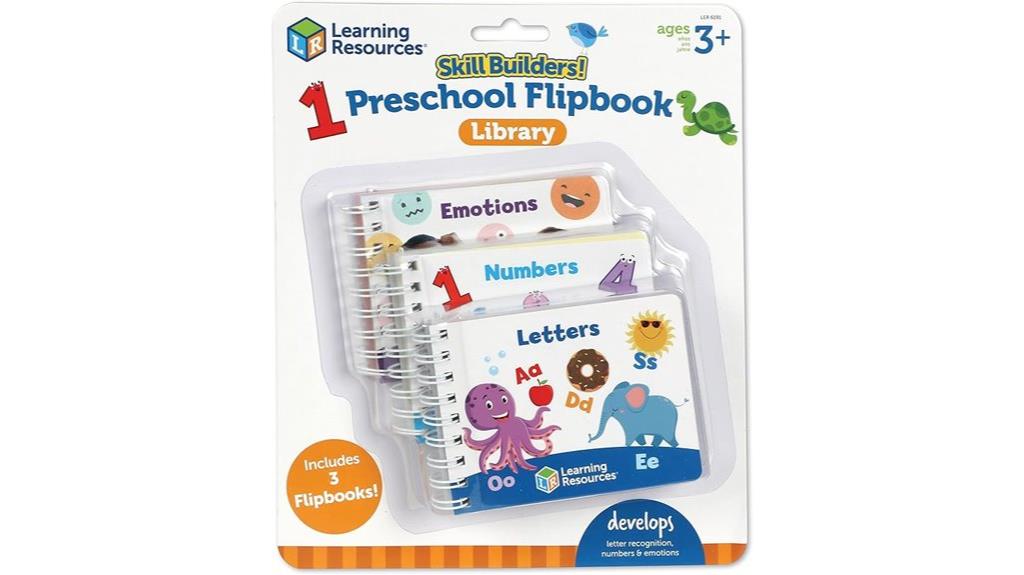
Looking for a versatile learning tool that keeps preschoolers engaged and promotes foundational skills? The Learning Resources Skill Builders! Preschool Flipbook set is perfect. It includes three durable, BPA-free spiral-bound books covering letters, numbers, and emotions, each with bright, full-color illustrations. These lightweight flipbooks support early literacy, numeracy, and social-emotional development through interactive, screen-free play. They help children recognize letters, count, and identify feelings with emoji and face images, fostering confidence and focus. Ideal for home, travel, or classroom use, these books grow with your child’s learning needs and are especially helpful for children with diverse needs.
Best For: preschoolers, parents, and educators seeking engaging, durable, and screen-free tools to support early literacy, numeracy, and social-emotional skills development.
Pros:
- Bright, full-color illustrations make learning appealing and engaging for young children
- Durable, BPA-free plastic construction withstands daily use and travel
- Supports multiple developmental areas including letter recognition, counting, and emotional awareness
Cons:
- Pages may occasionally stick together if not handled carefully
- Limited to basic skills; does not include advanced or interactive digital features
- Some children may outgrow the content quickly as they advance beyond preschool level
Literacy and the Youngest Learner (Teaching Resources)
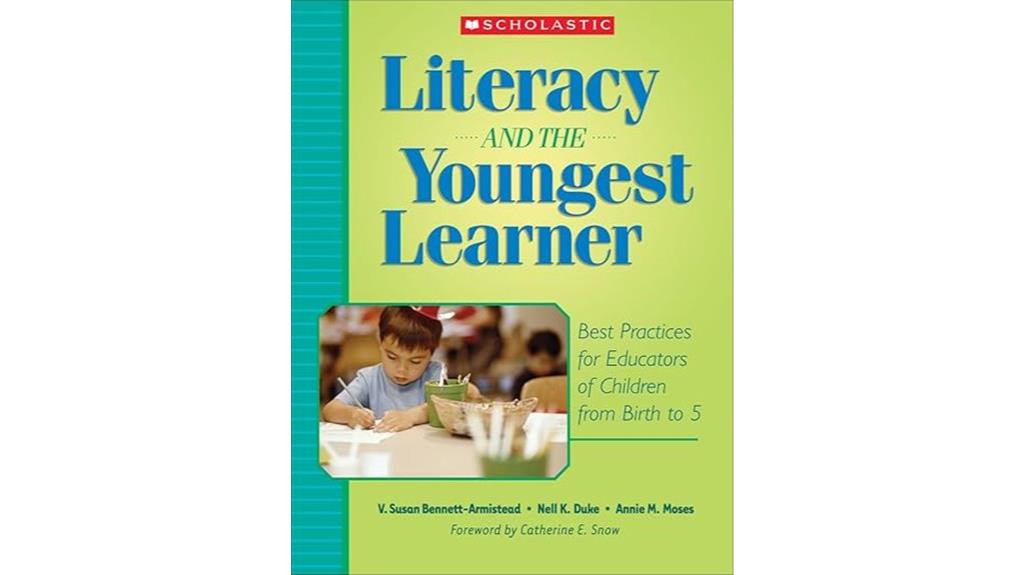
If you’re an early childhood educator seeking practical tools to foster literacy skills in young learners, “Literacy and the Youngest Learner” offers valuable teaching resources designed specifically for your needs. This book emphasizes the importance of early literacy development, highlighting how listening, speaking, reading, and writing skills start before elementary school. It provides strategies for creating literacy-rich environments with engaging spaces like book nooks and writing centers. The resource includes visual aids, photographs, and insights to support effective teaching practices. By focusing on active, enjoyable methods, it helps nurture foundational skills that set children up for future academic success.
Best For: early childhood educators seeking practical, engaging resources to foster foundational literacy skills in young learners before elementary school.
Pros:
- Provides comprehensive strategies for creating literacy-rich environments tailored to young children
- Includes visual aids, photographs, and insights that support effective teaching practices
- Emphasizes enjoyable, active learning methods that promote natural literacy development
Cons:
- May require additional materials or space modifications to fully implement suggested environment setups
- Focuses primarily on early childhood, which might be less relevant for educators teaching older age groups
- Some resources or activities might need adaptation for diverse learning needs and settings
Teaching Adults: An Esl Resource Book
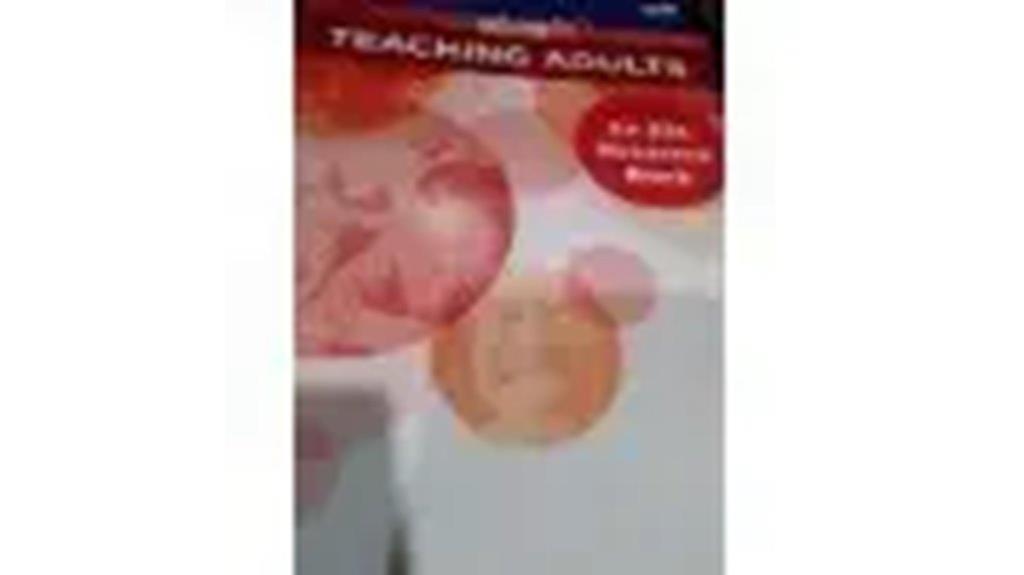
Teaching Adults: An ESL Resource Book stands out as an essential tool for educators who work specifically with adult English language learners. It offers practical support for lesson planning and addresses the unique needs of adult students. The book is flexible, serving as a supplement to various teaching methods and contexts. With 57 ready-to-use activities like Total Physical Response and conversational exercises, it simplifies lesson development. Designed specifically for adult learners, it helps teachers create engaging, effective lessons that meet their students’ language acquisition needs. This resource boosts teaching confidence and effectiveness, making it a must-have for any adult ESL educator in 2025.
Best For: ESL educators and tutors working with adult learners seeking practical, flexible resources to enhance lesson planning and student engagement.
Pros:
- Offers 57 ready-to-use activities tailored specifically for adult learners.
- Serves as a flexible supplement adaptable to various teaching styles and contexts.
- Focuses on practical tools that improve teaching effectiveness and boost confidence.
Cons:
- May require adaptation for use with very advanced or very young learners.
- Limited to adult ESL instruction, not suitable for children or teenage learners.
- Some activities might need additional materials or preparation for optimal implementation.
Teacher Created Resources Lesson Plan Book
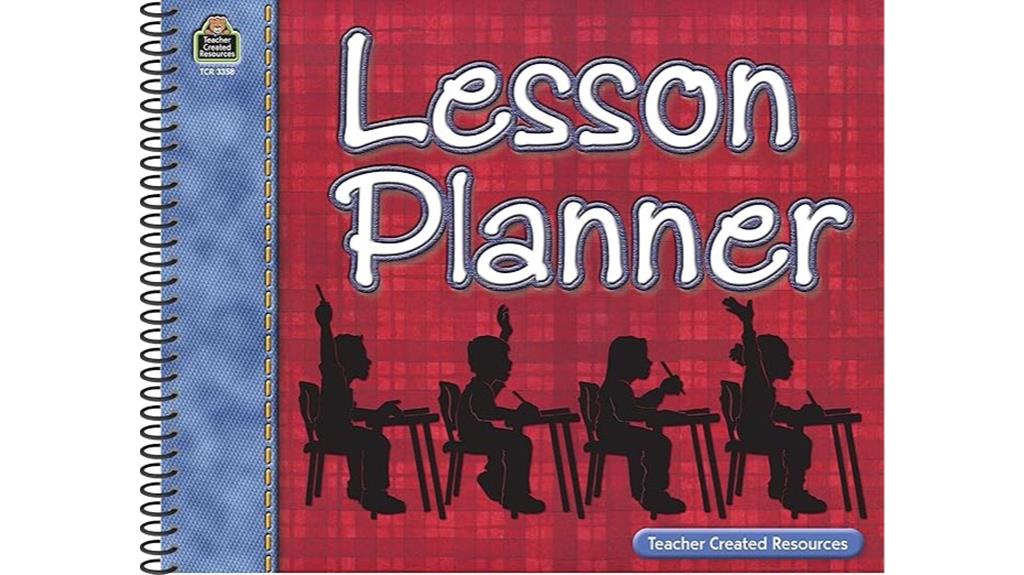
The Teacher Created Resources Lesson Plan Book is ideal for educators and homeschoolers who need a straightforward, customizable planner that offers ample space for detailed lesson planning. Its eight-column layout, large grid areas, and notes section make it easy to organize daily lessons, skills, and long-term goals. Users appreciate its simple design, affordability, and flexibility since it’s undated, allowing use at any time. The sturdy cover and spacious pages enhance usability, supporting classroom management, homeschool planning, and project tracking. Although some wish for more columns or modern covers, most find it practical and reliable for consistent, organized teaching and record-keeping throughout the year.
Best For: educators and homeschoolers seeking a simple, customizable planner with ample space for detailed lesson and record-keeping.
Pros:
- Spacious 8-column layout with large grid areas for comprehensive planning
- Undated design offers flexibility for year-round use
- Durable cover and uncluttered pages enhance usability and longevity
Cons:
- Limited to 8 columns, with some users wishing for 9-10 for more detailed labeling
- Dated cover design and minimal decorative elements may feel outdated to some users
- Shipping delays and desire for more modern or customizable covers have been reported
Teacher Created Resources Chalkboard Brights Lesson Plan and Record Book
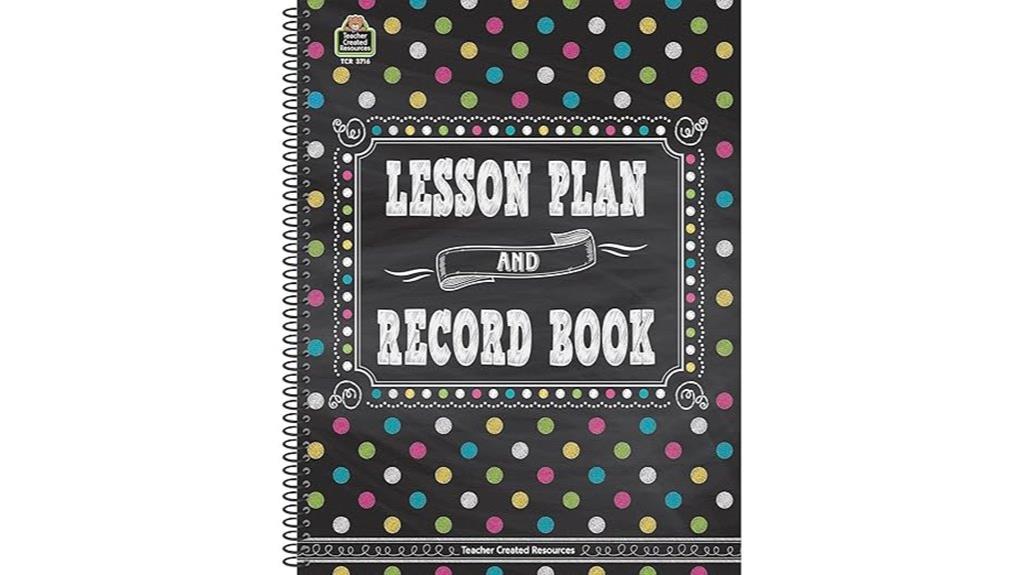
Designed for organized educators, the Teacher Created Resources Chalkboard Brights Lesson Plan and Record Book offers a thorough all-in-one solution for lesson planning and record keeping. Its spiral-bound design and large writing spaces make planning straightforward, with sections for weekly lessons, grades, attendance, and notes. Covering up to 40 weeks, it’s perfect for long-term tracking. Teachers appreciate its versatility, whether for elementary classes or music lessons. While some mention the cover arriving scuffed, durability remains solid. Overall, this planner simplifies organization, helping me stay on top of schedules, student info, and assessments in a practical, visually appealing format.
Best For: educators seeking a comprehensive, durable, and visually appealing paper planner for long-term lesson planning, record keeping, and organization throughout the school year.
Pros:
- Large writing spaces and multiple sections for detailed planning and record keeping
- Covers up to 40 weeks, ideal for long-term tracking of grades, attendance, and notes
- Versatile design suitable for various teaching environments, including elementary and music lessons
Cons:
- Cover may arrive scuffed and could scuff further with use
- Limited to paper-based organization, lacking digital integration options
- Slightly bulkier design due to extensive features, which may be less portable
Factors to Consider When Choosing a Teaching Resource Book

When selecting a teaching resource book, I consider how well its content matches my curriculum and students’ needs. I also look at whether the material is suitable for the age and grade level I teach, and if it’s easy to navigate. Finally, I prioritize books with clear visuals, practical resources, and features that support effective teaching.
Content Relevance and Scope
How do you determine if a teaching resource book truly fits your classroom needs? First, I check if the content aligns with current curriculum standards and covers essential skills for my students. It’s important that the scope matches my grade level and subject area, ensuring relevance without requiring too many supplemental materials. I also look for exhaustive content that supports my instructional goals and offers strategies for diverse learning styles, including differentiated activities. Additionally, I verify that the material reflects recent research and best practices, so I can confidently incorporate it into my teaching. When a resource’s content is focused, up-to-date, and tailored to my students’ needs, I know it will be a valuable tool in my classroom.
Age and Grade Appropriateness
Choosing a teaching resource book that matches your students’ age and grade level is essential for effective instruction. I always verify the content aligns with their developmental and literacy milestones, which helps them connect better with the material. It’s important to check that the difficulty and topics suit their cognitive and language abilities, preventing boredom or frustration. I look for resources that match students’ prior knowledge and skill levels to keep them engaged and challenged appropriately. Also, I consider whether the activities and instructional strategies are accessible yet stimulating for that specific age group. Finally, I pay attention to visual design, language complexity, and instructional approaches, making sure they suit the learners’ developmental stage for maximum understanding and growth.
Ease of Use
Ever wondered how to quickly find the information you need in a teaching resource book? The key is choosing one with clear organization—logical chapters, headings, and visual aids make navigation effortless. Practical tools like templates, checklists, and step-by-step instructions save valuable prep time and make implementation smoother. Look for user-friendly design elements, such as generous margins for notes and straightforward language, so concepts are easy to understand and apply. Beware of overly complex or cluttered layouts, which can slow you down or cause confusion. Accessibility features like digital formats or adjustable font sizes are also helpful, ensuring the book remains useful for diverse needs and learning environments. An easy-to-use resource empowers you to focus more on teaching and less on deciphering the material.
Visual and Design Elements
Effective visual and design elements can greatly enhance how easily you navigate and understand a teaching resource book. Clear, organized layouts help you find information quickly and grasp complex ideas more easily. Color coding, icons, and graphics highlight key concepts, making it easier to retain important content. Consistent use of fonts, spacing, and other design features creates a cohesive look that minimizes mental clutter. Well-designed covers and page layouts also boost the resource’s professional appeal and your engagement. Importantly, visuals should support the content—not overshadow it—so illustrations and graphics clarify concepts without causing distraction. When choosing a book, look for balanced, thoughtful design that enhances readability and comprehension, helping you make the most of your teaching materials.
Practical Application and Resources
Have you ever wondered what makes a teaching resource book truly practical and useful in the classroom? I believe it’s about more than just content—it’s about immediate applicability. A great resource offers ready-to-use materials like lesson plans, templates, and activities that can be implemented without extensive modification. It should include clear, step-by-step instructions and reproducible materials that support differentiation and meet diverse student needs. I also look for assessments and intervention strategies that help monitor progress and adjust instruction promptly. Ensuring the resource aligns with current research-based practices maximizes its effectiveness. Finally, the quality and durability of supplemental materials, like printable pages and manipulatives, are vital, as they need to withstand frequent classroom use. Practicality is key to making a resource genuinely beneficial.
Frequently Asked Questions
How Do These Books Address Diverse Learning Styles Effectively?
These books address diverse learning styles by offering practical strategies tailored to visual, auditory, kinesthetic, and reading/writing preferences. I find they provide activities and tools that help me customize lessons, ensuring each student’s needs are met. By incorporating varied approaches, I can engage learners more effectively, fostering an inclusive classroom where everyone has the opportunity to thrive. These resources truly help me adapt to the unique ways students absorb information.
Are These Resources Adaptable for Remote or Hybrid Classrooms?
Absolutely, these resources are versatile enough for remote or hybrid classrooms. I find they adapt well because they include digital tools and strategies that engage students online. While some books focus on in-person teaching, I appreciate how many offer practical advice for virtual engagement, tech integration, and flexible lesson planning. So, whether I’m teaching in a classroom or online, these resources help me stay effective and connected with my students.
What Criteria Should I Consider When Selecting a Teaching Resource Book?
When choosing a teaching resource book, I focus on relevance, ease of use, and flexibility. I look for materials that align with my curriculum and are adaptable to different teaching styles. It’s also important they include practical activities, clear explanations, and support diverse learners. I consider reviews and recommendations from trusted sources, ensuring the book offers innovative ideas that keep my lessons engaging and effective in any classroom setting.
How Frequently Should Educators Update or Supplement These Resources?
I believe educators should review and update their resources at least once a year to stay current with new research and teaching strategies. I also supplement resources whenever I notice gaps or when new curricula are introduced. Regular updates help me keep lessons engaging and relevant. Staying fresh with my materials guarantees I can adapt to students’ evolving needs and maintain a dynamic, effective classroom environment.
Do These Books Include Digital or Online Supplementary Materials?
These books often include digital and online supplements that supplement, support, and strengthen your teaching toolkit. I find that having access to interactive materials, videos, or online resources enhances engagement and understanding. Many publishers now bundle these bonuses to boost your teaching brilliance. So, yes, these books are not just static; they’re dynamic, digital, and designed to deliver diverse, digital delights to make your teaching truly transformative.
Conclusion
These books are my guiding stars, illuminating the path through the vast night of teaching challenges. Each resource acts as a compass, helping me navigate diverse learners and varied needs. Just as stars symbolize hope and direction, these tools anchor my purpose and inspire growth. With them, I feel more confident steering my classroom’s journey, knowing I carry a constellation of wisdom that brightens every lesson and fosters endless possibilities.
